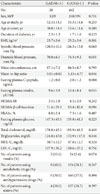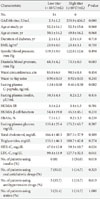1. MacCuish AC, Irvine WJ, Barnes EW, Duncan LJ. Antibodies to pancreatic islet cells in insulin-dependent diabetics with coexistent autoimmune disease. Lancet. 1974. 2:1529–1531.
2. Baekkeskov S, Aanstoot HJ, Christgau S, Reetz A, Solimena M, Cascalho M, Folli F, Richter-Olesen H, De Camilli P. Identification of the 64K autoantigen in insulin-dependent diabetes as the GABA-synthesizing enzyme glutamic acid decarboxylase. Nature. 1990. 347:151–156.
3. American Diabetes Association. Diagnosis and classification of diabetes mellitus. Diabetes Care. 2011. 34:Suppl 1. S62–S69.
4. Irvine WJ, McCallum CJ, Gray RS, Duncan LJ. Clinical and pathogenic significance of pancreatic-islet-cell antibodies in diabetics treated with oral hypoglycaemic agents. Lancet. 1977. 1:1025–1027.
5. Gottsater A, Landin-Olsson M, Fernlund P, Lernmark A, Sundkvist G. Beta-cell function in relation to islet cell antibodies during the first 3 yr after clinical diagnosis of diabetes in type II diabetic patients. Diabetes Care. 1993. 16:902–910.
6. Tuomi T, Groop LC, Zimmet PZ, Rowley MJ, Knowles W, Mackay IR. Antibodies to glutamic acid decarboxylase reveal latent autoimmune diabetes mellitus in adults with a non-insulin-dependent onset of disease. Diabetes. 1993. 42:359–362.
7. Turner R, Stratton I, Horton V, Manley S, Zimmet P, Mackay IR, Shattock M, Bottazzo GF, Holman R. UK Prospective Diabetes Study Group. UKPDS 25: autoantibodies to islet-cell cytoplasm and glutamic acid decarboxylase for prediction of insulin requirement in type 2 diabetes. Lancet. 1997. 350:1288–1293.
8. Zimmet PZ, Tuomi T, Mackay IR, Rowley MJ, Knowles W, Cohen M, Lang DA. Latent autoimmune diabetes mellitus in adults (LADA): the role of antibodies to glutamic acid decarboxylase in diagnosis and prediction of insulin dependency. Diabet Med. 1994. 11:299–303.
9. Niskanen LK, Tuomi T, Karjalainen J, Groop LC, Uusitupa MI. GAD antibodies in NIDDM. Ten-year follow-up from the diagnosis. Diabetes Care. 1995. 18:1557–1565.
10. Groop L, Groop PH, Koskimies S. Relationship between B-cell function and HLA antigens in patients with type 2 (non-insulin-dependent) diabetes. Diabetologia. 1986. 29:757–760.
11. Juneja R, Palmer JP. Type 1 1/2 diabetes: myth or reality? Autoimmunity. 1999. 29:65–83.
12. World Health Organization Department of Noncommunicable Disease Surveillance. Part 1, diagnosis and classification of diabetes mellitus. Definition, diagnosis and classification of diabetes mellitus and its complications: report of a WHO consultation. 1999. Geneva: World Health Organization;59.
13. Fourlanos S, Perry C, Stein MS, Stankovich J, Harrison LC, Colman PG. A clinical screening tool identifies autoimmune diabetes in adults. Diabetes Care. 2006. 29:970–975.
14. Gale EA. Latent autoimmune diabetes in adults: a guide for the perplexed. Diabetologia. 2005. 48:2195–2199.
15. Hosszufalusi N, Vatay A, Rajczy K, Prohaszka Z, Pozsonyi E, Horvath L, Grosz A, Gero L, Madacsy L, Romics L, Karadi I, Fust G, Panczel P. Similar genetic features and different islet cell autoantibody pattern of latent autoimmune diabetes in adults (LADA) compared with adult-onset type 1 diabetes with rapid progression. Diabetes Care. 2003. 26:452–457.
16. Hawa MI, Thivolet C, Mauricio D, Alemanno I, Cipponeri E, Collier D, Hunter S, Buzzetti R, de Leiva A, Pozzilli P, Leslie RD. Action LADA Group. Metabolic syndrome and autoimmune diabetes: action LADA 3. Diabetes Care. 2009. 32:160–164.
17. Tuomi T, Carlsson A, Li H, Isomaa B, Miettinen A, Nilsson A, Nissen M, Ehrnstrom BO, Forsen B, Snickars B, Lahti K, Forsblom C, Saloranta C, Taskinen MR, Groop LC. Clinical and genetic characteristics of type 2 diabetes with and without GAD antibodies. Diabetes. 1999. 48:150–157.
18. Cervin C, Lyssenko V, Bakhtadze E, Lindholm E, Nilsson P, Tuomi T, Cilio CM, Groop L. Genetic similarities between latent autoimmune diabetes in adults, type 1 diabetes, and type 2 diabetes. Diabetes. 2008. 57:1433–1437.
19. Park Y, Lee H, Koh CS, Min H, Rowley M, Mackay IR, Zimmet P, McCarthy B, McCanlies E, Dorman J, Trucco M. The low prevalence of immunogenetic markers in Korean adult-onset IDDM patients. Diabetes Care. 1996. 19:241–245.
20. Kim KA, Ahn KJ, Chung JH, Min YK, Lee MK, Oh PS, Jin DK, Kim BT, Park HJ, Kim KW, Lee MS. Combined measurements of anti-ICA512 and anti-GAD antibodies in insulin-dependent diabetes mellitus and slowly progressive insulin-dependent diabetes mellitus in Korea. J Korean Diabetes Assoc. 1998. 22:482–490.
21. Lee HH, Shin YG, Kim HS, Kim CY, Jeong YS, Kim HS, Park DW, Yoon KJ, Chung CH. Measurement of anti-GAD antibody by EIA and RIA methods in Korean diabetic patients: study for pathogenesis of slowly progressive IDDM. J Korean Diabetes Assoc. 1997. 21:231–242.
22. Ko KS, Hong SK, Lee KU, Kim NH, Choi DS, Ihm SH, Park SW, Kim CH, Byun DW, Suh KI, Chang HC, Rhee BD. The frequency of ICA and anti-GAD antibody in Korean IDDM and NIDDM patients. J Korean Diabetes Assoc. 1998. 22:312–319.
23. Kim CS, Park JA, Cho MH, Park JS, Nam JY, Kim DM, Ahn CW, Cha BS, Lim SK, Kim KR, Lee HC. The frequency of anti-GAD antibody in non-obese, adult-onset type 2 diabetes in Korea and clinical and biological characteristics according to anti-GAD antibody. J Korean Diabetes Assoc. 2004. 28:66–74.
24. Oh JH, Yoon JS, Won KC, Lee HW. Antibodies to GAD and ICA in type 2 DM with secondary failure of oral hypoglycemic therapy. J Korean Diabetes Assoc. 2007. 31:402–409.
25. Matthews DR, Hosker JP, Rudenski AS, Naylor BA, Treacher DF, Turner RC. Homeostasis model assessment: insulin resistance and beta-cell function from fasting plasma glucose and insulin concentrations in man. Diabetologia. 1985. 28:412–419.
26. Kasuga A, Maruyama T, Nakamoto S, Ozawa Y, Suzuki Y, Saruta T. High-titer autoantibodies against glutamic acid decarboxylase plus autoantibodies against insulin and IA-2 predicts insulin requirement in adult diabetic patients. J Autoimmun. 1999. 12:131–135.
27. Riley WJ, Maclaren NK, Krischer J, Spillar RP, Silverstein JH, Schatz DA, Schwartz S, Malone J, Shah S, Vadheim C, Rotter JI. A prospective study of the development of diabetes in relatives of patients with insulin-dependent diabetes. N Engl J Med. 1990. 323:1167–1172.
28. Pozzilli P, Di Mario U. Autoimmune diabetes not requiring insulin at diagnosis (latent autoimmune diabetes of the adult): definition, characterization, and potential prevention. Diabetes Care. 2001. 24:1460–1467.
29. Fourlanos S, Dotta F, Greenbaum CJ, Palmer JP, Rolandsson O, Colman PG, Harrison LC. Latent autoimmune diabetes in adults (LADA) should be less latent. Diabetologia. 2005. 48:2206–2212.
30. Naik RG, Palmer JP. Latent autoimmune diabetes in adults (LADA). Rev Endocr Metab Disord. 2003. 4:233–241.
31. Lee SA, Kim EY, Kim EH, Jeong JY, Jeong EH, Kim DW, Cho EH, Koh EH, Joong MS, Park Y, Lee KU. Anti-GAD antibody in patients with adult-onset diabetes in Korea. Korean Diabetes J. 2009. 33:16–23.
32. Takeda H, Kawasaki E, Shimizu I, Konoue E, Fujiyama M, Murao S, Tanaka K, Mori K, Tarumi Y, Seto I, Fujii Y, Kato K, Kondo S, Takada Y, Kitsuki N, Kaino Y, Kida K, Hashimoto N, Yamane Y, Yamawaki T, Onuma H, Nishimiya T, Osawa H, Saito Y, Makino H. Ehime Study. Clinical, autoimmune, and genetic characteristics of adult-onset diabetic patients with GAD autoantibodies in Japan (Ehime Study). Diabetes Care. 2002. 25:995–1001.
33. Fukui M, Nakano K, Shigeta H, Yoshimori K, Fujii M, Kitagawa Y, Mori H, Kajiyama S, Nakamura N, Abe N, Obayashi H, Fukui I, Ohta K, Ohta M, Kondo M. Antibodies to glutamic acid decarboxylase in Japanese diabetic patients with secondary failure of oral hypoglycaemic therapy. Diabet Med. 1997. 14:148–152.
34. Thai AC, Ng WY, Loke KY, Lee WR, Lui KF, Cheah JS. Anti-GAD antibodies in Chinese patients with youth and adult-onset IDDM and NIDDM. Diabetologia. 1997. 40:1425–1430.
35. Zinman B, Kahn SE, Haffner SM, O'Neill MC, Heise MA, Freed MI. ADOPT Study Group. Phenotypic characteristics of GAD antibody-positive recently diagnosed patients with type 2 diabetes in North America and Europe. Diabetes. 2004. 53:3193–3200.
36. Brophy S, Brunt H, Davies H, Mannan S, Williams R. Interventions for latent autoimmune diabetes (LADA) in adults. Cochrane Database Syst Rev. 2007. (3):CD006165.
37. Bosi EP, Garancini MP, Poggiali F, Bonifacio E, Gallus G. Low prevalence of islet autoimmunity in adult diabetes and low predictive value of islet autoantibodies in the general adult population of northern Italy. Diabetologia. 1999. 42:840–844.
38. Ruige JB, Batstra MR, Aanstoot HJ, Bouter LM, Bruining GJ, De Neeling JN, Heine RJ. The Hoorn Study. Low prevalence of antibodies to GAD65 in a 50- to 74-year-old general Dutch population. Diabetes Care. 1997. 20:1108–1110.







 PDF
PDF ePub
ePub Citation
Citation Print
Print



 XML Download
XML Download